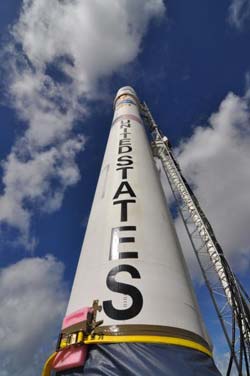NASA's Glory Satellite scheduled for launch March 4

The Taurus XL rocket stands on Space Launch Complex 576-E at Vandenberg Air Force Base in California. Credit: NASA/Randy Beaudoin, VAFB<br>
The March 4 liftoff from Vandenberg Air Force Base, Calif., is targeted for 5:09:43 a.m. EST, in the middle of a 48-second launch window. Spacecraft separation occurs 13 minutes after launch.
Data from the Glory mission will allow scientists to better understand how the sun and tiny atmospheric particles called aerosols affect Earth's climate. The Taurus XL also carries the first of NASA's Educational Launch of Nanosatellite missions. This auxiliary payload contains three small satellites called CubeSats, which were designed and created by university and college students.
NASA Television will carry launch coverage beginning March 4 at 3:30 a.m. EST. This coverage will be streamed live online at: http://www.nasa.gov/ntv
Real-time updates of countdown and launch milestones will be posted on NASA's launch blog beginning March 4 at 3:30 a.m. EST at: http://www.nasa.gov/glory
Media Contact
All latest news from the category: Physics and Astronomy
This area deals with the fundamental laws and building blocks of nature and how they interact, the properties and the behavior of matter, and research into space and time and their structures.
innovations-report provides in-depth reports and articles on subjects such as astrophysics, laser technologies, nuclear, quantum, particle and solid-state physics, nanotechnologies, planetary research and findings (Mars, Venus) and developments related to the Hubble Telescope.
Newest articles

Silicon Carbide Innovation Alliance to drive industrial-scale semiconductor work
Known for its ability to withstand extreme environments and high voltages, silicon carbide (SiC) is a semiconducting material made up of silicon and carbon atoms arranged into crystals that is…

New SPECT/CT technique shows impressive biomarker identification
…offers increased access for prostate cancer patients. A novel SPECT/CT acquisition method can accurately detect radiopharmaceutical biodistribution in a convenient manner for prostate cancer patients, opening the door for more…

How 3D printers can give robots a soft touch
Soft skin coverings and touch sensors have emerged as a promising feature for robots that are both safer and more intuitive for human interaction, but they are expensive and difficult…





















